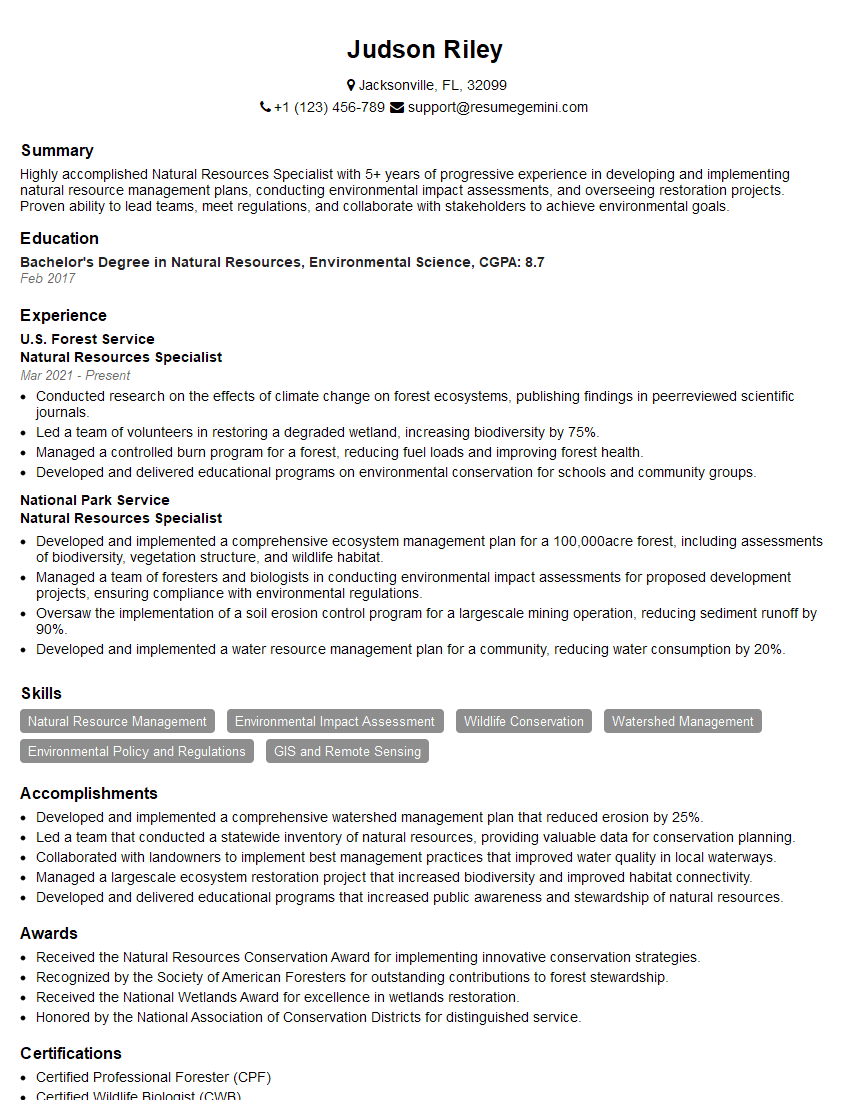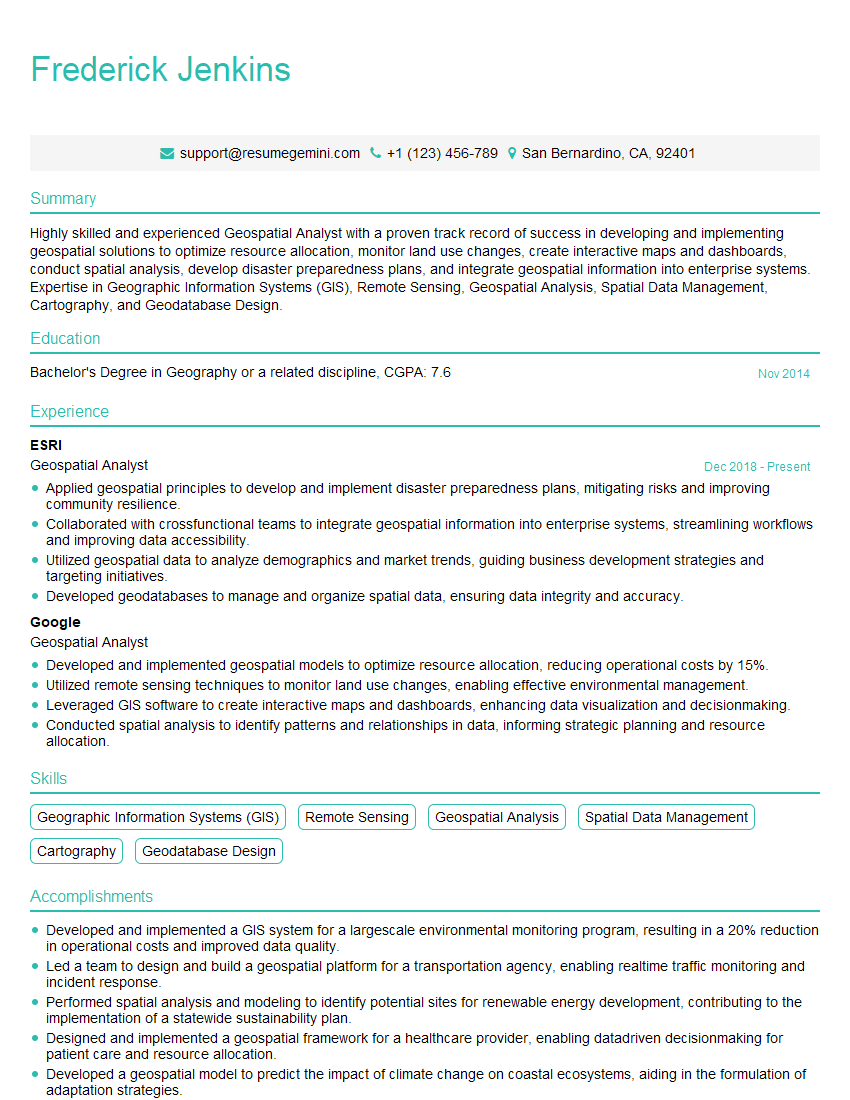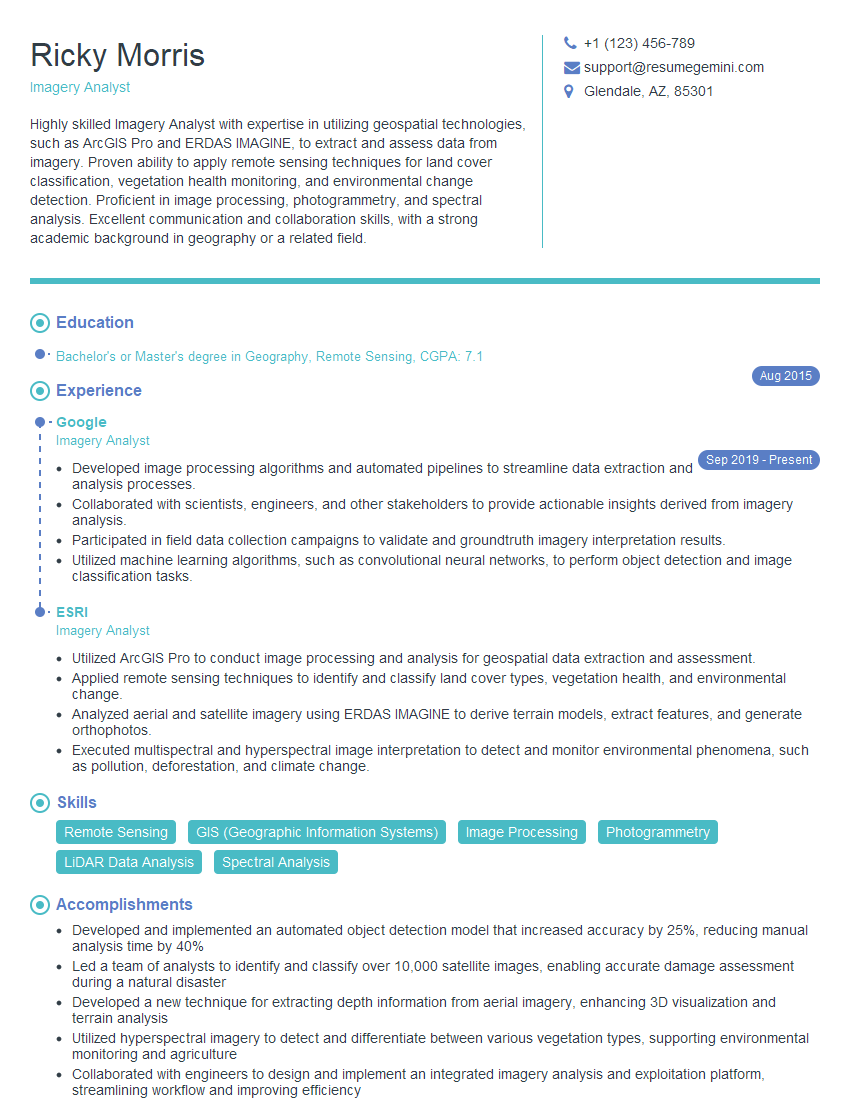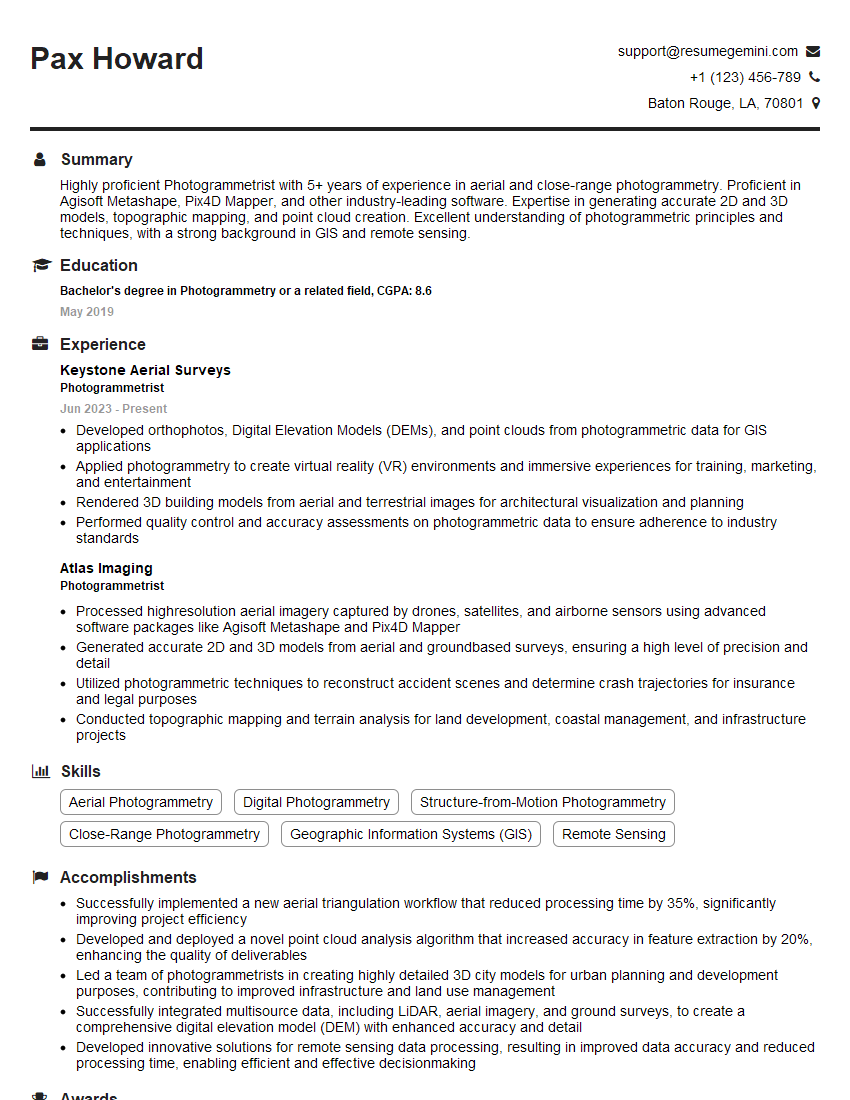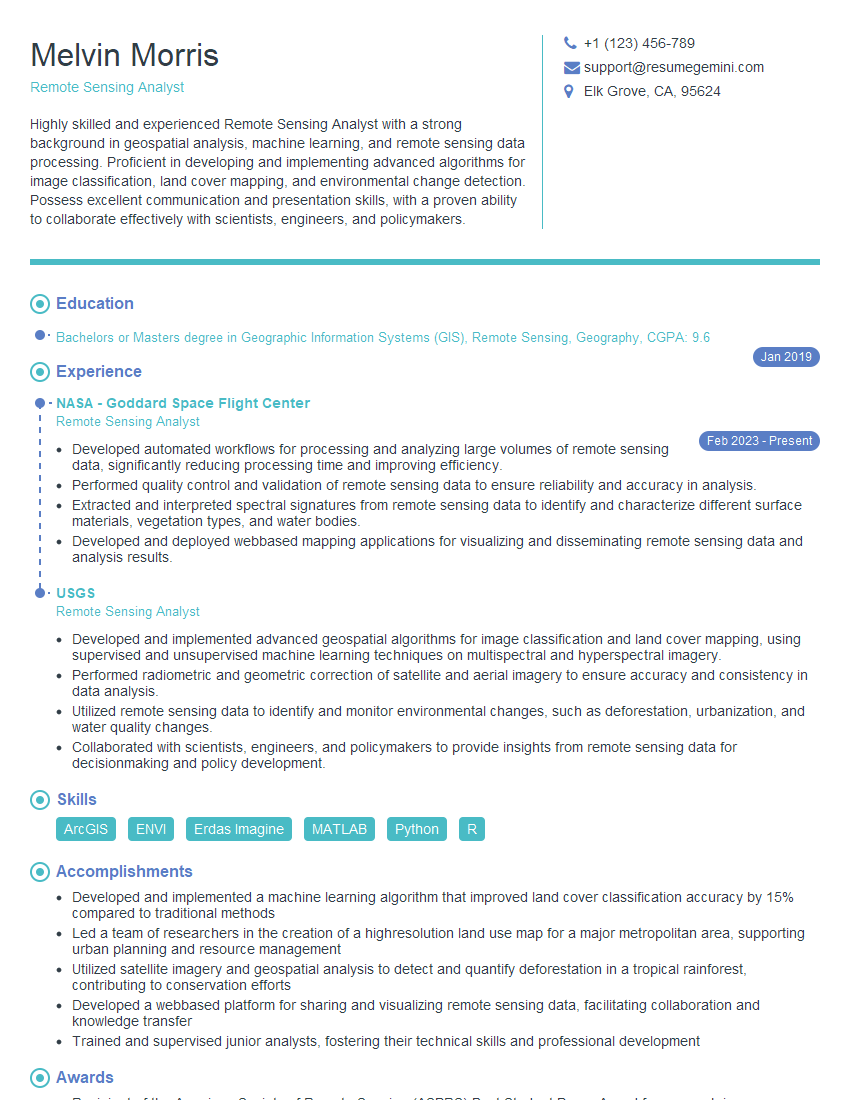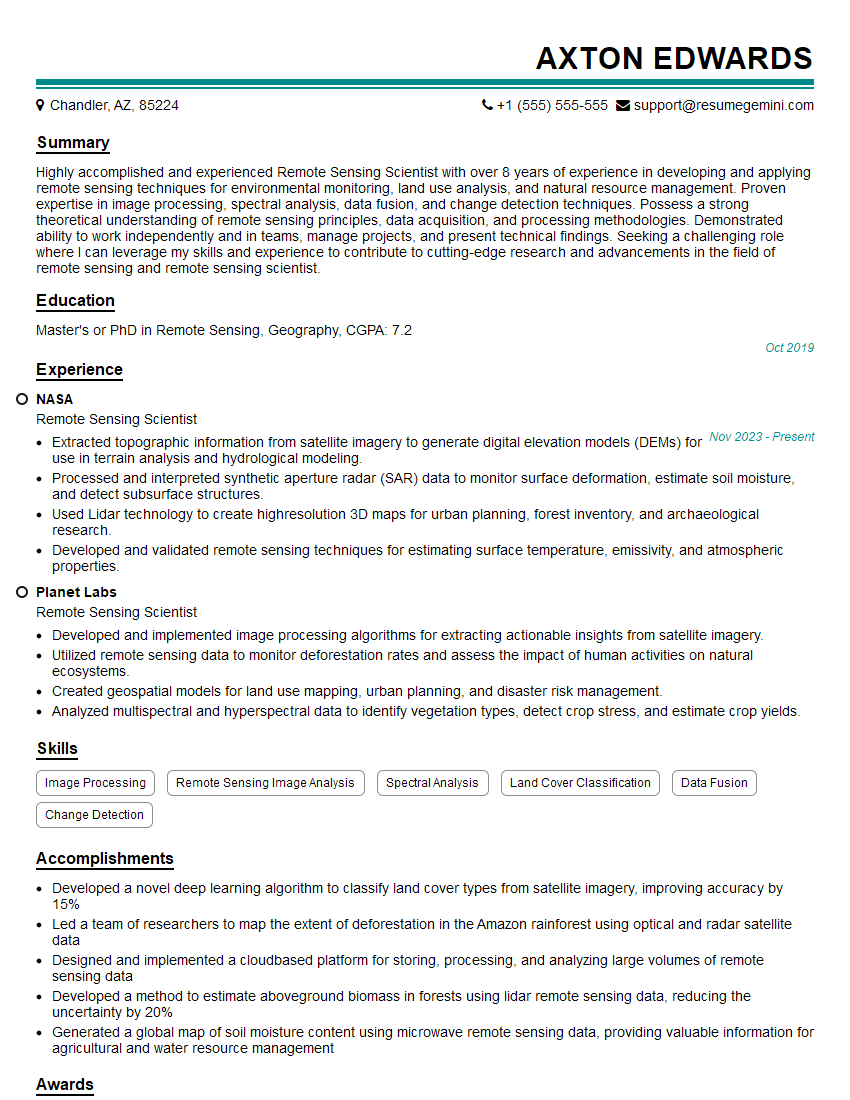Feeling uncertain about what to expect in your upcoming interview? We’ve got you covered! This blog highlights the most important Ability to interpret aerial photographs and satellite imagery interview questions and provides actionable advice to help you stand out as the ideal candidate. Let’s pave the way for your success.
Questions Asked in Ability to interpret aerial photographs and satellite imagery Interview
Q 1. What are the different types of aerial photography and what are their applications?
Aerial photography encompasses various types, each suited for different applications. The primary distinction lies in the film or sensor used and the resulting image characteristics.
- Vertical Photography: The camera is pointed directly downwards, producing images with minimal geometric distortion. This is ideal for creating accurate maps, orthophotos, and assessing land cover.
- Oblique Photography: The camera is tilted, offering a perspective view that’s beneficial for visual impact, showcasing landscapes, and identifying features not easily seen in vertical images. Think of those stunning cityscape shots.
- Near-Vertical Photography: A slight tilt from perfect vertical is acceptable, often a compromise between the need for perspective and minimal distortion. This is common in many aerial surveys.
- Infrared Photography: Uses film or sensors sensitive to infrared light, revealing information invisible to the naked eye. Healthy vegetation, for instance, reflects infrared light strongly, making it useful for agricultural monitoring and identifying stressed plants.
- Multispectral Photography: Captures images across multiple wavelengths simultaneously, providing data for vegetation analysis, geological mapping, and environmental monitoring. It forms the foundation for many remote sensing applications.
For example, vertical photography might be used to create a precise map of a construction site, while oblique photography could be used to showcase a new development for marketing purposes. Infrared photography could help farmers identify areas of drought stress in their fields.
Q 2. Explain the concept of orthorectification in aerial image processing.
Orthorectification is a crucial process in aerial image processing that corrects for geometric distortions caused by terrain relief, camera tilt, and Earth’s curvature. Imagine taking a photo of a mountain range – the slopes appear stretched and distorted. Orthorectification eliminates this, creating an image where all features appear in their correct planimetric positions, as if viewed directly from above.
The process involves using elevation data (often from Digital Elevation Models or DEMs) to mathematically model and remove these distortions. The resulting orthophoto is geometrically accurate and can be used for precise measurements and map creation. Think of it as straightening out a wrinkled map.
Without orthorectification, measurements taken directly from the image would be inaccurate. For instance, measuring the area of a field on a non-orthorectified image would yield an incorrect result. Orthorectification ensures accuracy, vital for applications like land surveying and urban planning.
Q 3. Describe the various spectral bands used in satellite imagery and their significance.
Satellite imagery employs various spectral bands, each capturing a portion of the electromagnetic spectrum. Different materials reflect and absorb light differently across these bands, allowing us to distinguish them.
- Visible Bands (e.g., blue, green, red): These are similar to the colours we see. Blue is often useful for water penetration, green for vegetation, and red for features like bare soil.
- Near-Infrared (NIR): Sensitive to wavelengths slightly longer than red. Healthy vegetation strongly reflects NIR light, making it excellent for vegetation health monitoring and biomass estimation.
- Shortwave Infrared (SWIR): Detects even longer wavelengths. Useful for detecting moisture content in soil and vegetation, differentiating rock types, and identifying certain minerals.
- Thermal Infrared (TIR): Detects heat radiation emitted by objects. Used for thermal mapping, monitoring volcanic activity, and detecting heat signatures associated with wildfires.
For example, a combination of NIR and red bands allows the creation of Normalized Difference Vegetation Index (NDVI), a widely used metric to assess vegetation health. Similarly, thermal infrared data can help in urban heat island studies.
Q 4. How do you identify and correct geometric distortions in aerial photographs?
Geometric distortions in aerial photographs arise from factors like camera tilt, aircraft movement, and Earth’s curvature. Correcting these distortions requires a systematic approach.
Methods include:
- Ground Control Points (GCPs): These are identifiable points on both the image and a map with known coordinates. Sophisticated software uses these points to mathematically model and rectify the image geometry.
- Direct Georeferencing: Modern cameras and sensors often have built-in GPS, providing accurate location data directly. This data is used to align the image to a geographic coordinate system.
- Image Matching and Rectification: Software algorithms identify common features between images (or between an image and a reference map) to automatically align and rectify the imagery.
The process involves using specialized software packages to perform these corrections. Without correction, accurate measurements and analysis are impossible. Imagine trying to measure a distance on a warped map; the result would be grossly inaccurate.
Q 5. What are the differences between panchromatic and multispectral imagery?
Both panchromatic and multispectral imagery are derived from remote sensing, but they differ significantly in their spectral range and applications.
- Panchromatic Imagery: Records a wide range of visible and near-infrared wavelengths as a single grayscale image. It’s characterised by high spatial resolution, meaning fine details are visible. Think of it as a highly detailed black and white photograph.
- Multispectral Imagery: Records information across several distinct spectral bands (e.g., red, green, blue, NIR). Each band is a separate image, providing spectral information not available in panchromatic imagery. This allows for the differentiation of materials based on their spectral signature.
Panchromatic imagery is excellent for visual interpretation and mapping, while multispectral imagery is used for thematic analysis, such as vegetation classification or mineral identification. Often, panchromatic and multispectral data are combined to leverage the advantages of both high spatial resolution and spectral information.
Q 6. Explain the process of image classification in remote sensing.
Image classification in remote sensing involves assigning each pixel in an image to a specific category or class based on its spectral characteristics. This allows us to map different land cover types, such as forests, water bodies, urban areas, etc.
Methods include:
- Supervised Classification: The user provides examples (training data) of each class to train the classifier. The algorithm then uses this information to classify the remaining pixels.
- Unsupervised Classification: The algorithm automatically groups pixels based on their spectral similarity without prior training data. This is useful when class information is limited.
- Object-Based Image Analysis (OBIA): This approach classifies objects (groups of pixels) rather than individual pixels. It considers both spectral and spatial information, leading to improved accuracy.
Classification results are typically displayed as thematic maps showing the spatial distribution of different land cover classes. This is vital for applications like land use planning, environmental monitoring, and resource management.
Q 7. How do you handle cloud cover in satellite imagery analysis?
Cloud cover is a major challenge in satellite imagery analysis as it obscures the ground surface. Several strategies can be employed to handle it.
- Image Selection: Choosing images with minimal cloud cover is the simplest approach, but may require waiting for suitable conditions.
- Cloud Masking: Identifying and removing cloud-covered pixels from the image using algorithms that detect cloud characteristics (brightness, texture). This requires careful parameterization to avoid accidentally removing other features resembling clouds.
- Cloud Filling: Estimating the values of cloud-covered pixels using neighbouring cloud-free pixels through interpolation or other techniques. This requires careful consideration to avoid introducing artefacts.
- Using Multiple Images: Combining data from several images acquired at different times to reduce the impact of cloud cover. This requires careful image registration and fusion techniques.
The best approach depends on the application and the severity of cloud cover. The goal is to obtain the most complete and accurate representation of the ground surface possible, despite the presence of clouds.
Q 8. What are the different methods used for image enhancement and sharpening?
Image enhancement and sharpening techniques aim to improve the visual quality and information content of aerial and satellite imagery. This is crucial because raw imagery often suffers from noise, blurring, and low contrast. Methods can be broadly categorized into spatial domain techniques and frequency domain techniques.
Spatial Domain Techniques: These operate directly on the image pixels. Examples include:
- Histogram equalization: Redistributes pixel intensities to enhance contrast, making features more visible. Think of it like adjusting the brightness and contrast controls on your photo editing software.
- Filtering (e.g., median, mean): Reduces noise by replacing pixel values with the median or mean of neighboring pixels. This is like smoothing out wrinkles in a picture.
- Sharpening (e.g., Unsharp masking, Laplacian): Increases the contrast of edges to make them crisper and more defined. This is like using a sharpening filter to make details pop.
Frequency Domain Techniques: These operate on the Fourier transform of the image, analyzing its frequency components. Examples include:
- Wavelet transforms: These decompose the image into different frequency bands, allowing for selective noise reduction or enhancement. It’s like separating the image into its different levels of detail.
- High-pass filtering: Emphasizes high-frequency components (edges), thus sharpening the image. Low-pass filtering does the opposite, smoothing it out.
The choice of method depends on the type of image, the nature of the degradation, and the desired outcome. For instance, a noisy image might benefit from median filtering before sharpening.
Q 9. Describe your experience with different GIS software (e.g., ArcGIS, QGIS).
My experience with GIS software spans over a decade, encompassing extensive use of both ArcGIS and QGIS. I’ve used ArcGIS primarily for large-scale projects requiring advanced spatial analysis and geoprocessing tools. Its powerful geodatabase management capabilities are invaluable for handling complex datasets. For example, I used ArcGIS to create a comprehensive land-use change map for a regional planning authority, integrating multi-temporal satellite imagery and ancillary data like census information.
QGIS, on the other hand, has proven incredibly versatile for smaller-scale projects and tasks requiring rapid prototyping. Its open-source nature and extensive plugin library provide a great deal of flexibility. I frequently use QGIS for quick image processing tasks like orthorectification and mosaicking, especially when dealing with freely available satellite data like Landsat or Sentinel. A recent example involved using QGIS to analyze deforestation patterns in a protected forest reserve using freely available satellite imagery and NDVI analysis.
Q 10. How do you determine the scale of an aerial photograph?
Determining the scale of an aerial photograph involves identifying the representative fraction (RF) or scale bar. The RF is a ratio expressing the relationship between the distance on the photograph and the corresponding distance on the ground. For example, a scale of 1:10,000 means that 1 unit on the photograph represents 10,000 units on the ground.
Methods for determining the scale:
Scale Bar: Many aerial photographs include a scale bar, providing a direct measurement. Simply measure the bar on the photograph and compare it to the known ground distance indicated.
Known Ground Distance: If a feature with a known ground length (e.g., a football field, road segment) is visible, measure its length on the photograph and calculate the RF.
Focal Length and Altitude: If the focal length of the camera and the flying height (altitude) are known, the scale can be calculated using the formula:
Scale = Focal Length / Flying Height. This is especially useful for unlabeled images.
It’s crucial to note that scale can vary slightly across a photograph due to factors like terrain relief, resulting in a non-uniform scale. This is often addressed through orthorectification, a process that corrects for geometric distortions.
Q 11. What are the limitations of using aerial and satellite imagery?
While aerial and satellite imagery offer invaluable data, limitations exist:
Atmospheric Effects: Clouds, haze, and atmospheric scattering can obscure features or reduce image clarity. This is particularly problematic in humid or cloudy regions.
Geometric Distortions: Perspective distortions, relief displacement (objects appear displaced vertically), and sensor inaccuracies can affect geometric accuracy. Orthorectification helps mitigate this, but it isn’t a perfect solution.
Temporal Resolution: The frequency at which images are acquired can limit the ability to monitor rapidly changing phenomena. This is especially important when studying events like floods or wildfires.
Spectral Resolution: The number of spectral bands captured can limit the information extractable about material properties. For example, distinguishing between different vegetation types often requires multispectral or hyperspectral imagery.
Cost and Accessibility: Acquiring high-resolution imagery can be expensive, and access to certain data may be restricted.
Shadowing: Deep shadows cast by tall objects can obscure information in those areas and make analysis difficult.
Understanding these limitations is essential for effective image interpretation and the selection of appropriate imagery for a given application.
Q 12. How do you interpret elevation data from aerial or satellite imagery?
Elevation data from aerial and satellite imagery can be extracted using several techniques:
Stereoscopic Analysis: This involves viewing two overlapping images simultaneously to create a 3D representation, allowing for manual measurement of elevations. It relies on the parallax (the apparent shift in an object’s position when viewed from different angles). This technique requires specialized software and experience.
Digital Elevation Models (DEMs): DEMs are raster datasets representing surface elevations. They can be derived from various sources, including stereoscopic photogrammetry, LiDAR (Light Detection and Ranging), and radar interferometry. DEMs are the most common and accurate way to extract elevation information. I often use DEMs in ArcGIS to analyze terrain slope, aspect, and drainage patterns.
Shadow Analysis: The length and direction of shadows cast by objects can provide an indication of elevation differences. While less accurate, this method is useful for preliminary estimations.
The choice of method depends on the accuracy required and the availability of data. For highly accurate elevation data, DEMs derived from LiDAR are generally preferred.
Q 13. Explain the concept of spatial resolution and its impact on image analysis.
Spatial resolution refers to the size of the smallest discernible detail in an image. It’s essentially the level of detail that can be seen. High spatial resolution means small pixels, resulting in a sharper image with finer details. Low spatial resolution means larger pixels, leading to a blurred image with less detail. Think of it like the resolution of your computer screen – higher resolution means sharper images.
The impact of spatial resolution on image analysis is significant:
Feature Identification: High spatial resolution is essential for identifying small features like individual trees or buildings. Low spatial resolution might only show large aggregates.
Accuracy of Measurements: High spatial resolution improves the accuracy of measurements, allowing for more precise estimations of area, length, and perimeter.
Computational Demands: High spatial resolution images have larger file sizes and require greater computational resources for processing and analysis.
Cost: High spatial resolution imagery is generally more expensive to acquire than low spatial resolution imagery.
Choosing the appropriate spatial resolution depends on the scale of the study area and the features of interest. For example, mapping individual trees requires higher resolution than mapping forest cover over a large region.
Q 14. What are the different types of sensors used in remote sensing?
Remote sensing employs various sensors to collect data about the Earth’s surface. These sensors can be broadly classified based on the type of energy they detect:
Passive Sensors: These detect naturally occurring radiation, primarily reflected or emitted from the Earth’s surface. Examples include:
- Cameras (e.g., aerial cameras, multispectral cameras): Capture images in various wavelengths of visible and near-infrared light.
- Thermal Infrared Sensors: Detect heat radiation emitted by objects, useful for monitoring temperature variations and thermal anomalies.
Active Sensors: These emit their own energy and measure the reflected signal. Examples include:
- LiDAR (Light Detection and Ranging): Uses lasers to measure distances to the ground, providing highly accurate elevation data.
- Radar (Radio Detection and Ranging): Uses radio waves to penetrate clouds and vegetation, useful for monitoring terrain and surface characteristics.
Each sensor type has its strengths and weaknesses, and the optimal choice depends on the application. For instance, LiDAR is ideal for creating highly accurate DEMs, while thermal infrared sensors are useful for monitoring wildfires or urban heat islands. The selection often involves trade-offs between spatial, spectral, and temporal resolution, cost, and data availability.
Q 15. How do you assess the accuracy of geospatial data derived from imagery?
Assessing the accuracy of geospatial data derived from imagery is crucial for reliable analysis. It involves a multi-faceted approach, combining ground truthing, comparing against existing datasets, and evaluating the image’s metadata.
Ground truthing involves physically visiting locations identified in the imagery and collecting data to verify the accuracy of the features and measurements. For example, if the imagery shows a road of a certain length, we’d use GPS to measure the actual road length on the ground for comparison. Discrepancies reveal potential errors in the imagery’s georeferencing or interpretation.
Comparison with existing datasets leverages established, high-accuracy data such as official land-use maps or topographic surveys. We align the imagery data with these reference datasets and quantify the differences. Root Mean Square Error (RMSE) is a commonly used metric in assessing this positional accuracy.
Metadata examination is equally important. The image metadata reveals details like sensor type, acquisition date, and processing techniques, all influencing accuracy. For instance, understanding the Ground Sample Distance (GSD) – the spatial resolution – helps determine the level of detail we can expect. A higher GSD allows for more precise measurements.
Ultimately, accuracy assessment is an iterative process. We use multiple methods to triangulate results and to identify and account for potential systematic errors or biases in the data.
Career Expert Tips:
- Ace those interviews! Prepare effectively by reviewing the Top 50 Most Common Interview Questions on ResumeGemini.
- Navigate your job search with confidence! Explore a wide range of Career Tips on ResumeGemini. Learn about common challenges and recommendations to overcome them.
- Craft the perfect resume! Master the Art of Resume Writing with ResumeGemini’s guide. Showcase your unique qualifications and achievements effectively.
- Don’t miss out on holiday savings! Build your dream resume with ResumeGemini’s ATS optimized templates.
Q 16. Describe your experience with image mosaicking and stitching.
Image mosaicking and stitching are essential for creating seamless, large-area images from multiple overlapping images. My experience involves using various software packages, including ERDAS IMAGINE and ArcGIS Pro, to achieve this. The process typically begins with precise georeferencing of individual images, ensuring they align accurately in terms of location and orientation.
I employ several techniques to handle challenges like variations in lighting, sensor differences, and geometric distortions. Seamline detection and correction algorithms identify areas of overlap and smooth out transitions between images, minimizing visible seams. Orthorectification is crucial to remove geometric distortions caused by terrain relief or sensor perspective. This ensures all images are projected onto a flat, map-like surface.
For example, in a recent project involving creating a large-scale land-use map, I mosaicked over 100 aerial photographs. The process involved rigorous quality control, including visual inspection to detect and correct any residual seams or mismatches. This resulted in a high-quality seamless mosaic, suitable for detailed analysis.
Q 17. What are the ethical considerations related to the use of aerial and satellite imagery?
Ethical considerations in using aerial and satellite imagery are paramount. Privacy is a major concern. Imagery can unintentionally capture sensitive information about individuals or properties, raising privacy violations. Anonymization techniques, such as blurring faces or obscuring specific locations, are often employed to mitigate this.
Informed consent is critical when using imagery involving people. For example, if we are using imagery to study a community, obtaining proper permission and explaining the purpose of the research is mandatory.
Data security is another aspect, ensuring that the imagery and derived data are protected from unauthorized access or misuse. Robust security protocols and access controls are necessary to safeguard sensitive information.
Finally, responsible data interpretation is key. Misinterpreting or misrepresenting information derived from imagery can have significant consequences. Transparency and careful analysis are essential to ensure accurate and fair representation.
Q 18. How do you perform change detection using time-series imagery?
Change detection using time-series imagery involves comparing images acquired at different times to identify changes in land cover or other features. A common approach is to use image differencing. This involves subtracting the pixel values of one image from another; resulting image highlights areas of significant change.
Image registration is crucial before differencing, ensuring both images are aligned precisely. This often involves using ground control points (GCPs) or image matching techniques. Then, after differencing, I frequently use thresholding to classify pixels as ‘changed’ or ‘unchanged’ based on difference magnitude.
More advanced methods like post-classification comparison involve classifying each image separately and then comparing the resulting land cover maps to identify areas of change. This allows for more nuanced change detection, such as distinguishing between different types of land-cover changes (e.g., forest to agriculture vs. forest to urban).
For instance, in monitoring deforestation, I might use Landsat time-series data to detect areas of forest loss over several years, which helps in deforestation monitoring and conservation efforts.
Q 19. Explain the concept of NDVI (Normalized Difference Vegetation Index) and its applications.
The Normalized Difference Vegetation Index (NDVI) is a widely used vegetation index derived from satellite imagery. It quantifies the amount of green vegetation by calculating the difference between near-infrared (NIR) and red reflectance values, then normalizing this difference. The formula is: NDVI = (NIR - Red) / (NIR + Red).
NDVI values range from -1 to +1. High positive values (close to +1) indicate dense, healthy vegetation, while low values (close to 0 or negative) suggest sparse vegetation or bare soil. This makes NDVI incredibly useful for monitoring vegetation health, agricultural yield assessment, and drought detection.
For instance, in precision agriculture, NDVI maps help farmers identify areas within their fields that require more attention or irrigation. Similarly, monitoring NDVI trends over time can help detect early warning signs of drought or other environmental stresses.
Q 20. How do you identify different land cover types from satellite imagery?
Identifying land cover types from satellite imagery involves a combination of visual interpretation and quantitative analysis. Visual interpretation relies on recognizing spectral signatures—the unique patterns of reflectance in different wavelengths—associated with different land cover classes (e.g., forests, water bodies, urban areas).
Quantitative analysis employs methods like supervised or unsupervised classification. Supervised classification involves training a classifier on known samples of different land cover types. The classifier then uses this training data to categorize all pixels in the image. Unsupervised classification groups pixels based on their spectral similarity without prior training data, useful when reference data is limited.
Additionally, texture analysis can be helpful, as different land cover types exhibit varying textural characteristics. For example, water bodies show smooth texture, while forests appear more textured. Software packages such as ENVI and QGIS provide tools for both visual and quantitative analysis, allowing for efficient and precise land cover mapping.
Q 21. Describe your experience using GPS data in conjunction with imagery analysis.
Integrating GPS data with imagery analysis significantly enhances the accuracy and precision of geospatial information. GPS provides accurate ground locations, which can be used for georeferencing imagery. This aligns the imagery to a known coordinate system, crucial for accurate measurements and spatial analysis.
I frequently use GPS data to collect ground control points (GCPs) during fieldwork. These GCPs are points with known coordinates that are identifiable in the imagery. These GCPs serve as references for georectification, improving the geometric accuracy of the imagery.
Moreover, GPS tracks can be overlaid onto imagery. For example, in a wildlife tracking project, GPS collar data from animals can be integrated with aerial imagery to understand animal movement patterns within their habitat. This provides a more complete understanding of animal behavior and ecology.
Q 22. What are the different file formats commonly used for aerial and satellite imagery?
Aerial and satellite imagery comes in various file formats, each with its strengths and weaknesses. The choice often depends on the sensor used, the intended application, and storage considerations. Common formats include:
- GeoTIFF (.tif, .tiff): This is a very popular format because it supports georeferencing, meaning the image is directly tied to a geographic coordinate system. This allows for easy integration with GIS software and precise spatial analysis. It also supports various compression techniques to manage file sizes.
- JPEG (.jpg, .jpeg): A widely used, lossy compression format. While it’s excellent for reducing file size, it’s not ideal for applications requiring high precision, as some image detail is lost during compression. It’s often used for quick previews or smaller-scale projects.
- HDF5 (.h5, .hdf5): This format is often used for very large datasets, particularly those containing multispectral or hyperspectral data. It’s designed for efficient storage and retrieval of large amounts of information.
- ERDAS Imagine (.img): A proprietary format used by ERDAS Imagine software, a popular GIS and remote sensing platform. It supports various data types and compression methods.
- NITF (.ntf): The National Imagery Transmission Format is a military standard, but it’s becoming more common in civilian applications. It’s robust and can handle large, complex datasets with extensive metadata.
Understanding these formats is crucial for efficient data handling and analysis. For instance, using a lossless format like GeoTIFF is essential when precise measurements are needed, while a lossy format like JPEG might suffice for quick visualizations.
Q 23. How do you manage large datasets of aerial and satellite imagery?
Managing large datasets of aerial and satellite imagery requires a strategic approach. Think of it like organizing a massive library – you wouldn’t just throw all the books in a pile! Effective management involves several key steps:
- Data Storage: Cloud storage solutions like Amazon S3, Azure Blob Storage, or Google Cloud Storage are often preferred for their scalability and cost-effectiveness. These services can handle petabytes of data.
- Database Management: A database (e.g., PostgreSQL/PostGIS) is vital for cataloging metadata about each image, such as acquisition date, sensor type, geographic location, and processing status. This allows for efficient searching and retrieval.
- Data Organization: A well-defined file structure is critical. Images should be organized geographically (e.g., by region or project) and chronologically. Using consistent naming conventions avoids confusion.
- Data Processing: Preprocessing steps like orthorectification (geometric correction) and atmospheric correction should be applied to ensure data quality and consistency. This often involves high-performance computing (HPC) resources for larger datasets.
- Data Visualization and Analysis: Software like ArcGIS Pro, QGIS, or ENVI are essential for visualizing and analyzing the data. Understanding the capabilities of these tools is critical for efficient workflow.
In my experience, a combination of cloud storage, a robust database system, and a well-planned workflow is essential for managing the complexities of these datasets efficiently and effectively. Ignoring these steps can lead to wasted time, lost data, and inaccurate analyses.
Q 24. Describe a time you had to troubleshoot a problem with image data.
During a large-scale urban planning project, we encountered an issue with a significant portion of our LiDAR data showing severe distortion. Initially, the data looked fine in initial visualizations, but upon closer inspection during DEM generation, clear geometric inconsistencies emerged. The error was only apparent after performing a rigorous quality check.
Our troubleshooting steps involved:
- Identifying the Extent of the Problem: We carefully examined the data using various visualization techniques and identified the affected areas.
- Investigating Metadata: We scrutinized the metadata associated with the LiDAR data, looking for clues about potential problems with acquisition or processing. We found inconsistencies in the GPS data associated with specific flight lines.
- Contacting the Data Provider: We reached out to the LiDAR acquisition company, highlighting our findings and sharing the relevant metadata. They confirmed a minor issue during data processing.
- Data Rectification: The provider re-processed the affected flight lines, providing us with corrected data. This involved advanced georeferencing techniques to align the data accurately.
- Data Validation: After receiving the corrected data, we performed further quality checks and validation steps to ensure the issue was completely resolved.
This experience highlighted the importance of thorough quality control at every stage of the project, from data acquisition to final analysis. It also emphasized the value of maintaining open communication with data providers to resolve unforeseen issues quickly and effectively.
Q 25. Explain your understanding of different map projections and their use in geospatial analysis.
Map projections are crucial in geospatial analysis because the Earth’s spherical surface cannot be accurately represented on a flat map without some distortion. Different projections minimize different types of distortion (area, shape, distance, direction). The choice of projection depends heavily on the application and the geographic area being mapped.
- Equidistant Projections: These preserve distances from one or more points. Useful for navigation.
- Conformal Projections: Preserve angles and shapes, making them ideal for navigation and mapping small areas accurately.
- Equal-Area Projections: Maintain the correct proportional areas of features, essential for thematic mapping and analyses involving area calculations.
- Examples: The Mercator projection (conformal) is widely known but severely distorts areas at high latitudes. The Albers Equal-Area Conic projection is frequently used for mapping large continental areas, preserving area accuracy.
In my work, I frequently use different projections depending on the task. For example, when analyzing land cover change over a large region, I might use an equal-area projection to ensure accurate area calculations. For creating navigation maps, a conformal projection might be a better choice to preserve the shapes and angles of features.
Q 26. How do you interpret shadows in aerial photography and their significance?
Shadows in aerial photography are a crucial source of information, often overlooked. They provide valuable three-dimensional context and help us interpret the shape, height, and orientation of objects. Analyzing shadows helps us determine the time of day the image was taken (the direction and length of shadows change throughout the day), as well as the sun’s elevation angle.
For example:
- Height Estimation: The length of a shadow cast by an object is directly related to its height and the sun’s angle. By measuring the shadow length and knowing the sun angle, we can estimate the object’s height.
- Feature Identification: Shadows can highlight subtle features that might be otherwise difficult to see, such as small depressions or changes in terrain.
- Orientation Determination: The direction of shadows indicates the sun’s azimuth, helping us orient ourselves within the image.
- Limitations: Overcast conditions eliminate shadows, making three-dimensional interpretation more challenging. Very long shadows can obscure features, and short shadows can make height estimation difficult.
By carefully studying shadows, we can extract valuable insights that enhance our overall interpretation of the aerial imagery, leading to more accurate analysis and mapping.
Q 27. Describe your experience with 3D modeling from aerial imagery.
I have extensive experience in generating 3D models from aerial imagery, primarily using Structure from Motion (SfM) photogrammetry techniques. SfM uses multiple overlapping images to automatically create a dense point cloud and subsequently a 3D model. This process leverages the parallax between images to reconstruct the scene’s geometry.
The workflow generally involves these steps:
- Image Acquisition: Obtaining high-resolution aerial images with significant overlap (typically 60-80%). Drone imagery is particularly well-suited for this.
- Image Processing: Using SfM software (e.g., Agisoft Metashape, Pix4D) to process the images. This involves automatically identifying matching points in overlapping images, creating a sparse point cloud, generating a dense point cloud, and building a 3D mesh.
- Texture Mapping: The process of draping the original images onto the 3D mesh to create a realistic visual representation.
- Model Refinement: This includes tasks such as cleaning up the model, removing artifacts, and potentially adding additional data (e.g., LiDAR) to improve accuracy.
- Export and Application: The 3D model can then be exported in various formats (e.g., OBJ, FBX) and used in various applications, such as virtual reality, urban planning, and infrastructure management.
I have used this technique to create 3D models for diverse projects, including documenting historical sites, monitoring construction progress, and assessing landslide damage. The resulting models provide invaluable three-dimensional representations for analysis and visualization purposes.
Key Topics to Learn for Ability to interpret aerial photographs and satellite imagery Interview
- Image Acquisition and Sensor Types: Understanding the different types of aerial photography and satellite imagery (e.g., panchromatic, multispectral, hyperspectral), their respective resolutions, and limitations.
- Photogrammetry and Georeferencing: Mastering techniques to accurately measure distances, areas, and elevations from imagery; understanding the process of aligning images to geographic coordinates.
- Image Interpretation Techniques: Developing proficiency in visual analysis, identifying key features (e.g., land cover, infrastructure, vegetation), and interpreting patterns and changes.
- Digital Image Processing: Familiarity with basic image enhancement and manipulation techniques to improve image clarity and extract relevant information (e.g., contrast adjustment, filtering).
- Geographic Information Systems (GIS) Integration: Understanding how to integrate aerial and satellite imagery into GIS workflows for spatial analysis and mapping applications.
- Practical Applications: Exploring case studies showcasing the use of aerial and satellite imagery in various fields like urban planning, environmental monitoring, agriculture, and disaster management.
- Problem-Solving and Critical Thinking: Developing skills in identifying inconsistencies, ambiguities, and limitations in imagery; formulating hypotheses and drawing meaningful conclusions from image analysis.
- Software Proficiency: Demonstrating knowledge and experience with relevant software such as ArcGIS, QGIS, ENVI, or ERDAS IMAGINE (mention specific software relevant to the target job description).
Next Steps
Mastering the ability to interpret aerial photographs and satellite imagery opens doors to exciting and impactful careers across diverse sectors. To maximize your job prospects, creating a compelling and ATS-friendly resume is crucial. ResumeGemini is a trusted resource that can help you build a professional resume that highlights your skills and experience effectively. ResumeGemini provides examples of resumes tailored to roles requiring expertise in interpreting aerial photographs and satellite imagery, allowing you to create a document that truly showcases your qualifications. Invest the time to craft a strong resume – it’s your first impression to potential employers.
Explore more articles
Users Rating of Our Blogs
Share Your Experience
We value your feedback! Please rate our content and share your thoughts (optional).
What Readers Say About Our Blog
Hi, I’m Jay, we have a few potential clients that are interested in your services, thought you might be a good fit. I’d love to talk about the details, when do you have time to talk?
Best,
Jay
Founder | CEO
